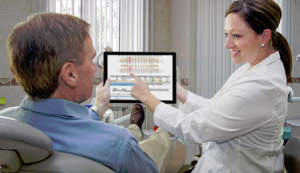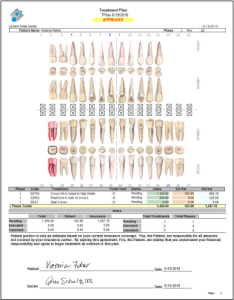How to Get to “Yes” in Case Presentation
Posted October 31, 2016 by Alexa S.
What is your initial thought as you walk into a new patient exam? As your patient begins to share the reason for their visit, where does your mind go? Odds are, you have started formulating a treatment plan before the patient has finished describing their problems; you have a solution in your head and are ready to get right to laying it all out for them. Hold up! Truly listening to your patient and preparing for how you’re going to present your treatment plan is imperative to gaining acceptance.
Time is money. Your time (and your patient’s) is valuable and should not be wasted. But, taking the time to explain the proposed treatment will help improve your case acceptance rate. Find your sweet spot. If you are unable to review the treatment plan chairside (or in a consult room), it is important to schedule a consult visit. Scheduling this time where you can  focus on the procedures and plan ahead will leave the patient feeling that you truly care about their well-being. Treatment Planning is easy with the realistic odontogram and efficient with the point-and-click interface of XLChart. You will have the ability to set multiple plan options if needed, giving you the flexibility to define different approaches to treat the same problem. Each option allows you to set various phases or appointments even going so far as defining time for each appointment to show your patient a clear map of their proposed treatment.
focus on the procedures and plan ahead will leave the patient feeling that you truly care about their well-being. Treatment Planning is easy with the realistic odontogram and efficient with the point-and-click interface of XLChart. You will have the ability to set multiple plan options if needed, giving you the flexibility to define different approaches to treat the same problem. Each option allows you to set various phases or appointments even going so far as defining time for each appointment to show your patient a clear map of their proposed treatment.
Case presentation should be a two-way street. You should leave time for your patient to address their questions and concerns about the suggested treatment, and don’t forget to ask for their feedback. Remember, this is a conversation, not a presentation in the typical sense, you do not want to overwhelm with too much, or not enough information. Every case should feel as though you’ve reach the solution together.
Dental terminology is Greek to many. Did you always know what an Abutment was, or what surface the Buccal referred to? If your patient needs a dictionary to understand your impressive dental knowledge and terminology, you lose case acceptance likelihood.
Operating on assumptions. While it is widely known that much of the population fears going to the dentist, and often the dental procedures themselves, it is not always a good idea to make these and other common assumptions. “Don’t worry.” Is this something you have ever said to a patient? Two of the most common barriers to case acceptance are phobias and finances. If your patient has concerns, be sure you allow enough time for them to raise these concerns during your case presentation. Don’t assume they are scared, or that finances are the cause of the case acceptance outcome.
Documentation. Have you ever had a patient come into your office, talking about their friend whose dentist let them get XYZ procedure done, and you “just did ABC”, and didn’t provide the same option? What do you think happened here? Did you really only give them one option?  Likely the answer is no. However, do you have that documented in their file? A common mistake in clinical charting, as well as case presentation, is the lack of documentation in providing options. Often times, when a patient decides on a route of treatment, the other options that were presented get deleted. If your practice management software does not allow you to keep track of “rejected” treatment plans, you should consider how you can go back and reference this. Luckily, with XLDent, you are able to easily access proposed, accepted, and rejected treatment plans all within the tooth chart. Plans can easily be reviewed and signed digitally by the patient using a tablet PC, keeping everything in their electronic chart. You can create alternate options and keep them as a precaution. Remember to have a Standard Operating Process (SOP) for documenting all phases of the treatment plan and retaining them. If it isn’t written down or in their electronic record, it did not happen.
Likely the answer is no. However, do you have that documented in their file? A common mistake in clinical charting, as well as case presentation, is the lack of documentation in providing options. Often times, when a patient decides on a route of treatment, the other options that were presented get deleted. If your practice management software does not allow you to keep track of “rejected” treatment plans, you should consider how you can go back and reference this. Luckily, with XLDent, you are able to easily access proposed, accepted, and rejected treatment plans all within the tooth chart. Plans can easily be reviewed and signed digitally by the patient using a tablet PC, keeping everything in their electronic chart. You can create alternate options and keep them as a precaution. Remember to have a Standard Operating Process (SOP) for documenting all phases of the treatment plan and retaining them. If it isn’t written down or in their electronic record, it did not happen.
So, what do you do now with all of this information? Keep in mind that having a “yes” attitude gives you the confidence and positive determination to meet your goals. It is important to review with your team, your specific goals and how to achieve them. The beautiful thing about confidence is that it is contagious, you and your team can share this attitude with your patients and it will improve your case acceptance rate. Believe that you and your team are offering the very best care and treatment plan for your patients, and they too will believe it. Often times, patients are looking for validation that they have made the right decision for their treatment plan, their doctor, and their overall care. It is important that you reassure them in their decision from the minute they walk in the door, to when they leave – as a team! Following these ideas and using XLDent Practice Management Software can give you all the tools you need to create treatment plans that get you to “yes”

 Subscribe
Subscribe Subscribe
Subscribe



